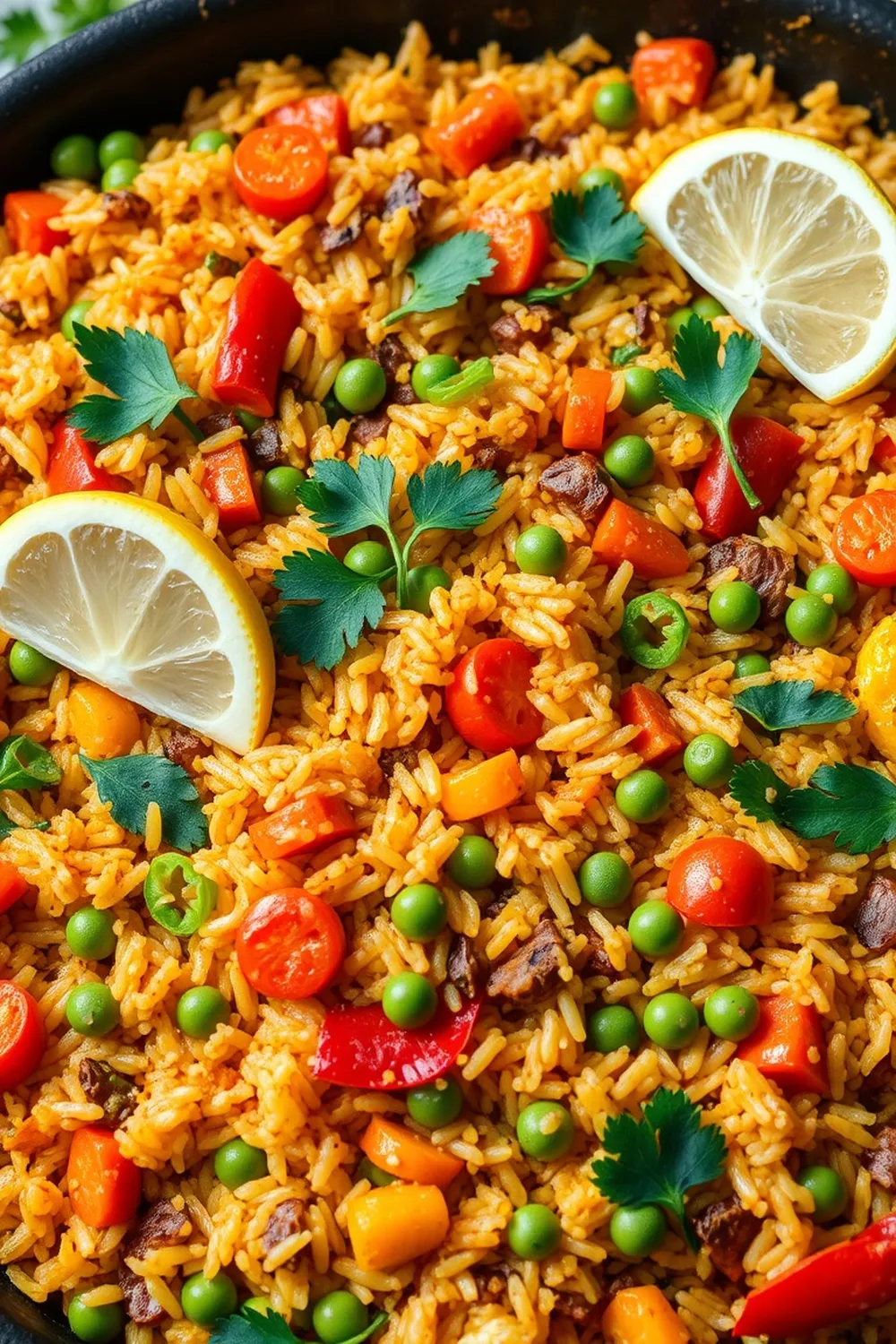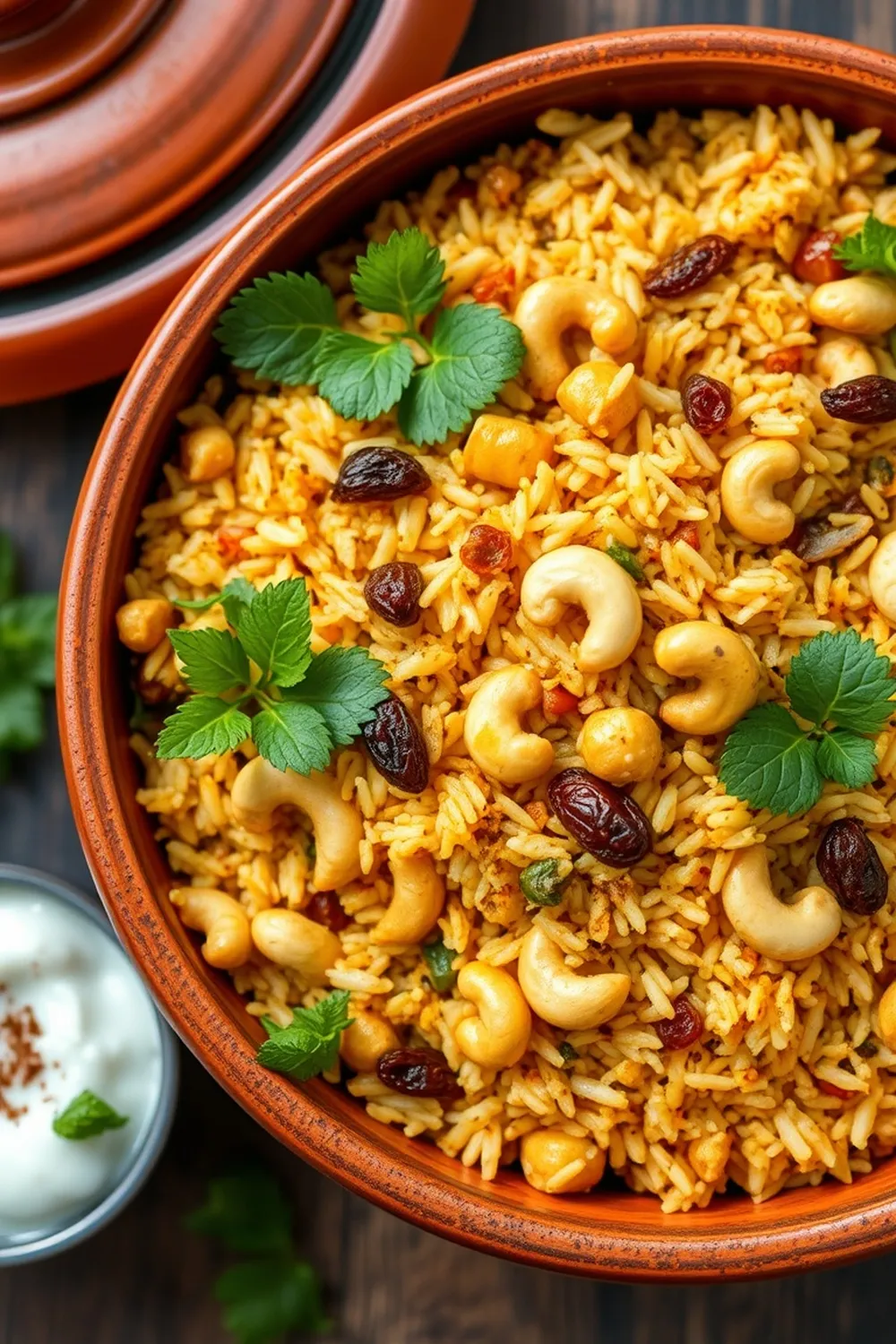- Heat oil and ghee in a pot. Add bay leaf, clove, cardamom, star anise, and cinnamon. Sauté for 30 seconds. Add sliced onions and cook until golden (4-5 minutes). Stir in chopped tomatoes and sauté until soft (4 minutes).
- Add the ground coconut-spice paste to the pot. Fry on low heat for 8-10 minutes until aromatic. Season with salt. Add rice and mix well for 1 minute.
- Pour 2 ½ cups water into the pot. Bring to a boil, then reduce heat. Cover and simmer until rice is fully cooked (15-20 minutes).
- Garnish with fresh coriander leaves. Serve hot with yogurt, pickle, or a curry of choice.
- Calories:320 kcal25%
- Energy:1338 kJ22%
- Protein:6 g28%
- Carbohydrates:58 mg40%
- Sugar:5 mg8%
- Salt:150 g25%
- Fat:8 g20%
Last Updated on 4 months by Neha Deshmukh
Coconut Rice Recipe – Authentic Indian Flavors & Spices
Hey everyone! If you’re anything like me, you absolutely love the comforting aroma and delicate flavor of coconut rice. It’s a staple in so many Indian homes, and honestly, it just feels like a warm hug in a bowl. I remember the first time I tried to make it myself – it wasn’t perfect, but the journey to perfecting this recipe has been so rewarding! Today, I’m sharing my go-to method for incredibly fragrant and delicious coconut rice.
Why You’ll Love This Recipe
This isn’t just any coconut rice recipe. It’s packed with authentic Indian flavors, thanks to the careful blend of spices and, of course, fresh coconut. It’s surprisingly easy to make, even if you’re new to Indian cooking. Plus, it’s incredibly versatile – perfect as a side dish with your favorite curry, or even enjoyed on its own! You’ll love how the subtle sweetness of the coconut complements the savory spices.
Ingredients
Here’s what you’ll need to create this aromatic delight:
- 1 ½ cups raw rice (Basmati works beautifully!)
- 10-12 curry leaves
- 1 clove
- 1 cardamom
- 1 inch cinnamon stick
- 1 star anise
- 1 large onion, finely sliced
- 3 ripe tomatoes, finely chopped
- ½ tbsp coriander leaves (for garnish)
- Salt to taste
- 1 tbsp oil
- ½ tbsp ghee
- ½ tbsp coriander seeds (dry roasted)
- ½ tsp cumin seeds (dry roasted)
- 1 tsp saunf (dry roasted)
- 4-5 tbsp grated fresh coconut
- 1 inch ginger
- 5 garlic flakes
- 3 cloves
- 1 inch cinnamon stick
- 1 cardamom
- 1 tbsp coriander leaves
- 6-7 mint/pudina leaves
- 1-2 green chillis
- 2 shallots or small onion
Ingredient Notes
Let’s talk ingredients! A few things make this recipe special. First, dry roasting the spices (coriander seeds, cumin seeds, and saunf) is key. It really wakes up their flavors and adds a depth you won’t get otherwise. Just a few minutes in a dry pan until fragrant is all it takes.
Then there’s the ghee. Don’t skip it! Ghee adds a richness and aroma that oil simply can’t replicate. But if you’re avoiding ghee, oil works too.
And finally, fresh coconut is the star. It makes all the difference. If fresh isn’t available, you can use unsweetened desiccated coconut, but the flavor won’t be quite as vibrant.
Coconut rice variations are huge across India. In South India, you’ll often find it made with coconut milk and a touch of mustard seeds. Bengali versions sometimes include a hint of sweetness and dried fruits. This recipe leans towards a more North Indian style, but feel free to experiment!
Step-By-Step Instructions
Alright, let’s get cooking!
- Heat the oil and ghee in a heavy-bottomed pot. Add the bay leaf, clove, cardamom, star anise, and cinnamon stick. Sauté for about 30 seconds until fragrant. This is where the magic begins!
- Add the sliced onions and cook until they turn golden brown – about 4-5 minutes. Patience is key here; nicely browned onions are crucial for flavor.
- Stir in the chopped tomatoes and sauté until they soften, around 4 minutes. They should break down and become a bit jammy.
- Now, for the spice paste! Grind together the coriander seeds, cumin seeds, saunf, grated coconut, ginger, garlic, cloves, cinnamon stick, cardamom, coriander leaves, mint leaves, and green chillis into a smooth paste. Add this paste to the pot and fry on low heat for 8-10 minutes, stirring frequently, until it’s beautifully aromatic. Season with salt.
- Add the rice and mix well for about a minute, ensuring each grain is coated in the flavorful paste.
- Pour in 2 ½ cups of water. Bring to a boil, then reduce the heat to the lowest setting. Cover the pot tightly and simmer for 15-20 minutes, or until the rice is fully cooked and all the water is absorbed. Resist the urge to peek!
- Once cooked, fluff the rice gently with a fork.
Expert Tips
- Rice to Water Ratio: This is important! I find 2 ½ cups of water to 1 ½ cups of rice works perfectly, but adjust slightly depending on your rice type.
- Don’t Overcook: Overcooked rice will be mushy. Keep a close eye on it during the simmering stage.
- Resting Time: Let the rice rest, covered, for 5-10 minutes after cooking. This allows the flavors to meld even further.
Variations
- For my family, I sometimes add a handful of cashews and raisins during the last 5 minutes of cooking for a touch of sweetness and crunch.
- My friend Priya loves to add a pinch of turmeric to the spice paste for a beautiful golden color and extra health benefits.
- If I’m feeling lazy, I’ll use pre-made ginger-garlic paste – it’s a lifesaver!
Vegan Adaptation
Simply substitute the ghee with an equal amount of vegetable oil. It won’t have quite the same richness, but it will still be delicious!
Gluten-Free Adaptation
This recipe is naturally gluten-free! Just double-check that your spices are sourced from a gluten-free facility if you have severe allergies.
Spice Level Adjustment (Mild, Medium, Spicy)
- Mild: Reduce the number of green chillies to 1 or omit them entirely.
- Medium: Use 1-2 green chillies.
- Spicy: Add 3-4 green chillies or a pinch of cayenne pepper to the spice paste.
Festival Adaptations (Onam, Pongal, etc.)
Coconut rice is a traditional dish for many South Indian festivals like Onam and Pongal. For Onam, you might add a pinch of saffron for a beautiful color. For Pongal, it’s often served with sambar and chutney.
Serving Suggestions
Coconut rice is incredibly versatile! It pairs beautifully with:
- Chicken or vegetable curries
- Dal (lentil soup)
- Raita (yogurt dip)
- Pickle
- Or simply enjoyed on its own!
Storage Instructions
Leftover coconut rice can be stored in an airtight container in the refrigerator for up to 3 days. Reheat gently with a splash of water to restore moisture.
FAQs
What type of rice is best for coconut rice?
Basmati rice is my go-to! Its long grains and delicate flavor work beautifully. However, you can also use other long-grain rice varieties.
Can I use coconut milk instead of fresh coconut?
Yes, you can! Use about 1 cup of full-fat coconut milk in place of the grated fresh coconut. The flavor will be slightly different, but still delicious.
How can I adjust the sweetness of the coconut rice?
If you prefer a sweeter rice, add a teaspoon of sugar or jaggery to the spice paste.
What is the purpose of dry roasting the spices?
Dry roasting enhances the flavor and aroma of the spices, adding depth to the dish.
How do I prevent the rice from sticking to the bottom of the pot?
Use a heavy-bottomed pot and keep the heat on the lowest setting during simmering. Stirring occasionally can also help.










